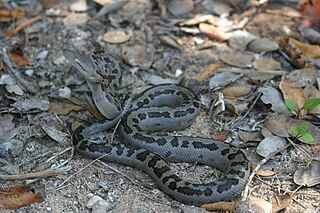
Chilabothrus exsul, the Abaco Island boa or Northern Bahamas boa, is a boa species found in the Bahamas. No subspecies are currently recognized. Like all other boas, it is not venomous.

Spilotes pullatus, commonly known as the caninana, tiger rat snake, chicken snake, yellow rat snake, or serpiente tigre, is a species of large nonvenomous colubrid snake endemic to warmer parts of the Americas.

The Puerto Rican boa is a large species of boa endemic to Puerto Rico. It is a terrestrial snake with a dark brown coloration. It grows to 1.9 m (6.2 ft) in length. It feeds on small mammals such as rodents and bats, birds and sometimes anole lizards. Like most boas, it is viviparous and kills its prey using constriction.
The Yunnan keelback is a species of natricine snake which is endemic to Asia.
Doria's green snake is a species of snake in the family Colubridae. The species is endemic to Asia.

Hydrophis caerulescens, commonly known as the dwarf sea snake, is a species of venomous sea snake in the family Elapidae.

Hydrophis melanocephalus, commonly known as the slender-necked sea snake, is a species of venomous sea snake in the family Elapidae.

The Japanese keelback is a species of colubrid snake, which is endemic to Asia.

The Cuban boa, also known as the Cuban tree boa and by locals as maja de Santa María, is a very large species of snake in the family Boidae. With lengths exceeding 5 m (16 ft) and a relatively heavy build, the Cuban boa is one of the largest snakes in the world. The species is native to Cuba and some nearby islands. No subspecies are currently recognized.
Brachyophis is a monotypic genus created for the rear-fanged venomous snake species, Brachyophis revoili, commonly known as Revoil's short snake, which is endemic to Eastern Africa. Three subspecies are recognized as being valid.

Chilabothrus chrysogaster, commonly known as the Turks and Caicos Islands boa or the Southern Bahamas boa, is a species of snake found in the Southern Bahamas and the Turks and Caicos Islands. Local names include the rainbow boa, the Bahamas cat boa, the rainbow snake, and the fowl snake. Like all boids, it is not a venomous species.
Micrelaps vaillanti, also known commonly as the black-headed micrelaps or the Somali two-headed snake, is a species of venomous rear-fanged snake in the family Lamprophiidae. The species is endemic to Africa.
Aparallactus jacksonii, or Jackson's centipede-eater, is a species of venomous rear-fanged snake in the family Atractaspididae.
Aparallactus werneri, or the Usambara centipede-eater, is a species of venomous rear-fanged snake in the family Lamprophiidae. The species is endemic to Tanzania.

Chilabothrus monensis, also called the Virgin Islands boa in the Virgin Islands, and possibly sometimes as the Mona Island boa elsewhere, is a species of snake in the family Boidae. It is native to the West Indies.

Chilabothrus fordii, known commonly as Ford's boa or the Haitian ground boa, is a species of snake in the family Boidae.

Chilabothrus striatus, the Hispaniolan boa, is a species of snake in the family Boidae. The species is endemic to Hispaniola. The species is regularly found in the international pet trade.

Eryx jaculus, known commonly as the javelin sand boa, is a species of snake in the Boidae family. It is the type species of the genus Eryx.

The black file snake, also known commonly as the dwarf file snake or the Nyassa file snake, is a species of snake in the subfamily Lamprophiinae of the family Lamprophiidae. The species is endemic to Africa.
Chilabothrus schwartzi, also known as the Crooked-Acklins boa or Crooked Aklins boa, is a species of snake. It is endemic to the southern Bahamas, specifically to Crooked Island and Acklins. It was originally described as a subspecies of Epicrates chrysogaster, but it was elevated to full species status in 2018. In fact, molecular data suggest a closer relationship with Chilabothrus argentum than with Chilabothrus chrysogaster.













